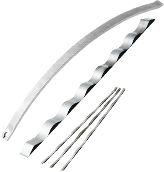Spring Design
Design information for engineers, such as spring calculation formulas,
which are the basis of spring design, can be found here.
- Tokai Spring HOME
- Spring Design
- Flat Springs: Things To Note in Spring Design
Flat
Springs
(1)Consideration of Material Rolling Direction
The properties of leaf springs such as tensile strength, elastic limit, and yield point are improved by cold work, but elongation, drawability, and bendability are reduced. These mechanical characteristics differ depending on the material rolling direction. This is especially noticeable for materials with a high degree of workability and materials such as stainless steel strips and phosphor bronze sheets (whose mechanical properties have been improved by high cold working) that require particular attention paid to which direction the material should be cut. For springs subject to bending, the bending line should be perpendicular to the rolling direction.
(2)Bending Radius
In the case of leaf springs (especially flat springs), they may be subject to lots of bending. With regard to the bending radius, stress concentration occurs at bent parts. The smaller the bending radius, (r) with respect to the plate thickness (t), the larger the stress concentration factor and the higher the possibility cracks may occur. Because of these factors, it is recommended to increase the bending radius.
(3)Holes, Notches, Burrs, Scratches
Stress concentration occurs not only at the bent part of (2), but also due to holes, notches, and sudden changes in cross-sectional shape.
Notches should be avoided as much as possible.
The burrs generated by press punching deteriorates the material’s bendability as well as subjecting the material to concentrated stress. This must be given careful consideration.


















